Mullins L.J. Management and organisational behaviour, Seventh edition
Подождите немного. Документ загружается.


In the previous chapter we mentioned that how people behave and perform as mem-
bers of a group is as important as their behaviour or performance as individuals, and
drew attention to the importance of effective teamwork. Our main focus of attention
in this chapter is the actual roles, behaviours and performance of people working in
groups or teams. Once again, however, we should be aware of the tendency for the
terms ‘groups’ and ‘teams’ to be used interchangeably. ‘To remain competitive organi-
sations need to make optimum use of equipment and people if they are to thrive or
even survive … In a general sense people talk of teamwork when they want to empha-
sise the virtues of co-operation and the need to make use of the various strengths of
employees.’
1
In order to help improve the performance of the organisation it is necessary to
understand the nature of human relationships and what goes on when groups of
people meet.
2
Working in a group is likely to be both a psychologically rewarding, but
also a potentially demanding, experience for the individual. Group performance and
the satisfaction derived by individuals are influenced by the interactions among mem-
bers of the group. As an example of this, Figure 14.1 gives an unsolicited commentary
from five final-year business studies degree students after completing a group-based
assignment. In order to understand the functions and processes of a group, it is neces-
sary to understand what happens when people meet; the actions and behaviour of
individual members; the parts people play; the patterns of interactions and forces
within the group; and influences on individual and group performance. According to
Guirdham, for example:
Many of the concepts that have helped us understand interactive behaviour in work relationships
are also needed for understanding it in groups, including role behaviour, norms and co-opera-
tion, competition, conflict and conflict resolution. Most of what there is to understand about
group work applies equally to both decision-making groups and teams but there are some fur-
ther issues particular to the two different kinds of groups. There is, however, no suggestion that
teams do not have to solve problems!
3
If groups are to be successful and perform effectively there must be a spirit of unity and
co-operation. Members of a group must work well together as a team. As Crainer
reminds us, in most teams people will contribute individual skills many of which will
be different. However, referring to the work of Obeng,
4
Crainer points out that it is not
enough to have a rag-bag collection of individual skills.
The various behaviors of the team members must mesh together in order to achieve objectives.
For people to work successfully in teams, you need people to behave in certain ways. You need
some people to concentrate on the task at hand (doers). You need some people to provide spe-
cialist knowledge (knowers) and some to solve problems as they arise (solvers). You need some
people to make sure that it is going as well as it can and that the whole team is contributing fully
(checkers). And you need some people to make sure that the team is operating as a cohesive
social unit (carers).
5
Although everyone operates fundamentally as a loner at work, James draws attention to
the need in most jobs for the eponymous ‘teamworking’.
The idea, as you probably know, is that teams achieve more than individuals. Throw people into a
random group and somewhere along the line their mutual strengths will outweigh their individ-
ual weaknesses. This of course depends upon the dynamics of the team. If it works, great. If not,
disaster. Any team, no matter how hand-picked and honed, can be brought down if there is an
outbreak of whingeing, bitching, favouritism, office politics, laziness, negativity, stupidity, inter-
nal competition, power-posturing, back stabbing … in fact, all and any of the usual suspects.
6
CHAPTER 14 WORKING IN GROUPS AND TEAMS
INTERACTIONS AMONG MEMBERS
555
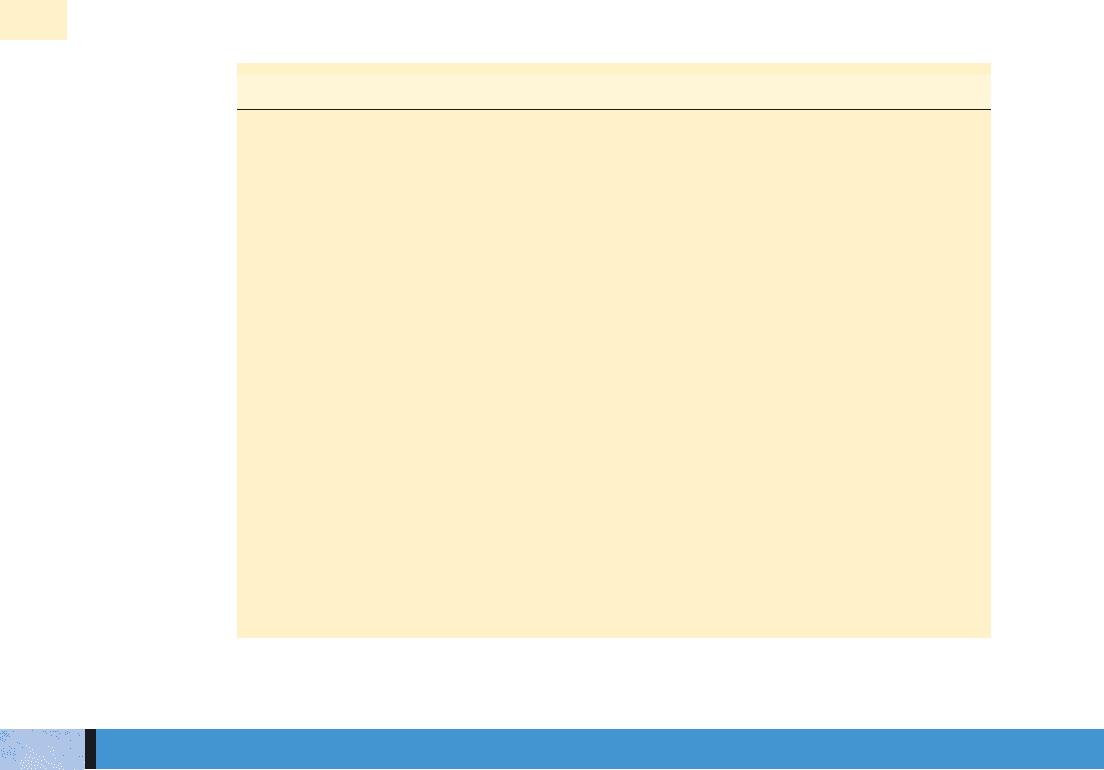
556
PART 5 GROUPS AND TEAMWORK
One of the most popular and widely used analyses of individual roles within a work
group or team is that developed by Meredith Belbin. Following years of research and
empirical study, Belbin concludes that groups composed entirely of clever people, or of
people with similar personalities, display a number of negative results and lack creativ-
ity. The most consistently successful groups comprise a range of roles undertaken by
various members. The constitution of the group itself is an important variable in its
success.
7
Initially, Belbin identified eight useful types of contribution – or team-roles. A
team-role is described as a pattern of behaviour, characteristic of the way in which one
team member interacts with another whose performance serves to facilitate the
progress of the team as a whole. In a follow-up publication, Belbin discusses the con-
tinual evolution of team-roles, which differ in a few respects from those originally
identified and adds a ninth role.
8
Strength of contribution in any one role is com-
monly associated with particular weaknesses. These are called allowable weaknesses.
Members are seldom strong in all nine team-roles. A description of the evolved nine
team-roles is given in Table 14.1.
The types of people identified are useful team members and form a comprehensive
list. These are the key team-roles and the primary characters for successful teams.
Creative teams require a balance of all these roles and comprise members who have
characteristics complementary to one another. ‘No ones’s perfect, but a team can be.’
Belbin claims that good examples of each type would prove adequate for any chal-
lenge, although not all types are necessarily needed. Other members may be welcome
for their personal qualities, for example a sense of humour, but experience suggests
there is no other team-role that it would be useful to add.
WHAT WE FEEL WE HAVE LEARNT FROM WORKING IN A GROUP
1‘We learnt that we had to listen to everybody’s points of view and take these into consideration.’
2‘We found that we had to be prepared to make certain sacrifices and adopted a democratic
decision process. However, if an individual felt very strongly about a specific point and
persisted with a valid argument then this had to be included.’
3‘We often felt frustrated.’
4 ‘It was time-consuming and difficult to schedule meetings due to differences in timetables and
preferences in working hours.’
5‘We learnt that it is good to pool resources because this increased the overall standard of the
piece of work. We feel this was only because we all set high personal standards and expected
these from our fellow group members. We learnt that it is possible to work in other less
productive groups where individual levels of achievement may decrease.’
6‘We learnt that it is better to work in a smaller and not a larger group, as there is a tendency for
individual ideas to be diluted.’
7 ‘Groups formed on the basis of friendship alone are not as effective as groups formed with work
as the major influence. The former tend to be unproductive.’
8‘We found that it was good to get positive response, encouragement and feedback from team
members. Likewise, it was demotivating to receive a negative response.’
9‘We learnt a lot about our individual personalities.’
10 ‘We benefited from sharing personal experiences from our industrial placements.’
11 ‘It is important to separate work and personal relationships.’
Figure 14.1 Unsolicited commentary from students after completing a group-based assignment
BELBIN’S TEAM-ROLES

CHAPTER 14 WORKING IN GROUPS AND TEAMS
557
Roles and descriptions – team-role contribution Allowable weaknesses
Plant Creative, imaginative, unorthodox. Ignores details. Too preoccupied
Solves difficult problems. to communicate effectively.
Resource Extrovert, enthusiastic, communicative. Over-optimistic. Loses interest
investigator Explores opportunities. Develops once initial enthusiasm has passed.
contacts.
Co-ordinator Mature, confident, a good chairperson. Can be seen as manipulative.
Clarifies goals, promotes decision- Delegates personal work.
making. Delegates well.
Shaper Challenging, dynamic, thrives on Can provoke others. Hurts people’s
pressure. Has the drive and courage feelings.
to overcome obstacles.
Monitor- Sober, strategic and discerning. Lacks drive and ability to inspire
Evaluator Sees all options. Judges accurately. others. Overly critical.
Team worker Co-operative, mild, perceptive and Indecisive in crunch situations.
diplomatic. Listens, builds, averts Can be easily influenced.
friction, calms the waters.
Implementer Disciplined, reliable, conservative Somewhat inflexible. Slow to
and efficient. Turns ideas into respond to new possibilities.
practical actions.
Completer Painstaking, conscientious, anxious. Inclined to worry unduly. Reluctant
Searches out errors and omissions. to delegate. Can be a nit-picker.
Delivers on time.
Specialist Single-minded, self-sharing, dedicated. Contributes on only a narrow front.
Provides knowledge and skills in Dwells on technicalities. Overlooks
rare supply. the ‘big picture’.
Table 14.1 Belbin’s evolved nine team-roles
(Reprinted with permission from Belbin, R. M., Team Roles at Work, The Butterworths Division of Reed Elsevier (UK) Limited/ Belbin
Associates (1993) p. 23.)

The most consistently successful teams were ‘mixed’ with a balance of team-roles. The
role that a person undertakes in a group is not fixed and may change according to cir-
cumstances. Individuals may have a ‘back-up team-role’ with which they have some
affinity other than their primary team-role. If certain roles were missing members would
call upon their back-up roles. Team-roles differ from what Belbin calls ‘functional-roles’.
These are the roles that members of a team perform in terms of the specifically technical
demands placed upon them. Team members are typically chosen for functional roles on
the basis of experience and not personal characteristics or aptitudes.
Belbin has developed a Self-Perception Inventory designed to provide members of a
group with a simple means of assessing their best team-roles.
The value of Belbin’s Team-Roles Inventory
A study undertaken by Furnham, Steel and Pendleton had the aim of examining the psycho-
metric properties of the Belbin Team-Role Self Perception Inventory. They believe
(admittedly from relatively small samples) that there is little psychometric support for the
structure of the inventories which do not give confidence in the predictive or construct
validity. In a response, Belbin argues that the Inventory was a quick and useful way of inti-
mating to readers what their own team-roles might be; and Furnham, Steele and Pendleton
acknowledge that Belbin’s contribution is substantial and his measure imaginative.
9
Despite possible doubts about the value of Belbin’s Self-Perception Inventory, it
remains a popular means of examining and comparing team-roles. For example, in order
to explore whether local government managers were distinctively different from the
model of private sector management, Arroba and Wedgwood-Oppenheim compared samples
of the two groups of managers and Belbin’s key team-roles. There were noticeable similar-
ities between the two groups with the noticeable exception of the marked difference
between private sector managers and local government officers in the score for team
workers and the team-roles they preferred to adopt. The individual characteristics of
managers in the two sectors differed. The data implied that local government officers
were committed to organisational objectives and dedicated to task achievement but the
low score for team workers suggested the high commitment to organisational tasks was
not supplemented by a concern for interpersonal processes. In local government, the
drive and enthusiasm and emphasis on task were exaggerated, while attention to idea
generation and productive interpersonal relationships was less marked.
10
Referring to the research of Belbin, White refers to a team in the proper sense of the
word as something about the way they work as a group that adds up to a sum greater
than the individual parts – a collective spirit, a managerial alchemy that makes them
such a force. If business people are happy to accept that group effort is always better
than individuals working in isolation, the research of Belbin may help in constructing
the perfect team. White suggests that in the end it is all about trust. The chances are
that the dream team is out there, sitting opposite you or just around the corner. All
you have to do is to fit them into Belbin’s nine defined roles.
11
Using Belbin’s model, Fisher et al. undertook a study of the distribution of team roles
among managers. Over the past 15 years many layers of management have been
removed and the gap in people to lead and motivate has increasingly been filled by the
creation of multitudes of teams. The participants of the study were 1441 male and 355
female managers, all with some management experience. All had completed a person-
ality questionnaire, and were candidates short-listed for a range of management
positions in both the private and public sector. The study analysed data supplied by
ASE/NFER Publishing Company and results were then compared with the Belbin
model. The data broadly agreed with the Belbin model. The authors conclude that as
558
PART 5 GROUPS AND TEAMWORK
Back-up
team-roles and
functional
roles
Constructing
the perfect
team
Distribution of
team roles
among UK
managers
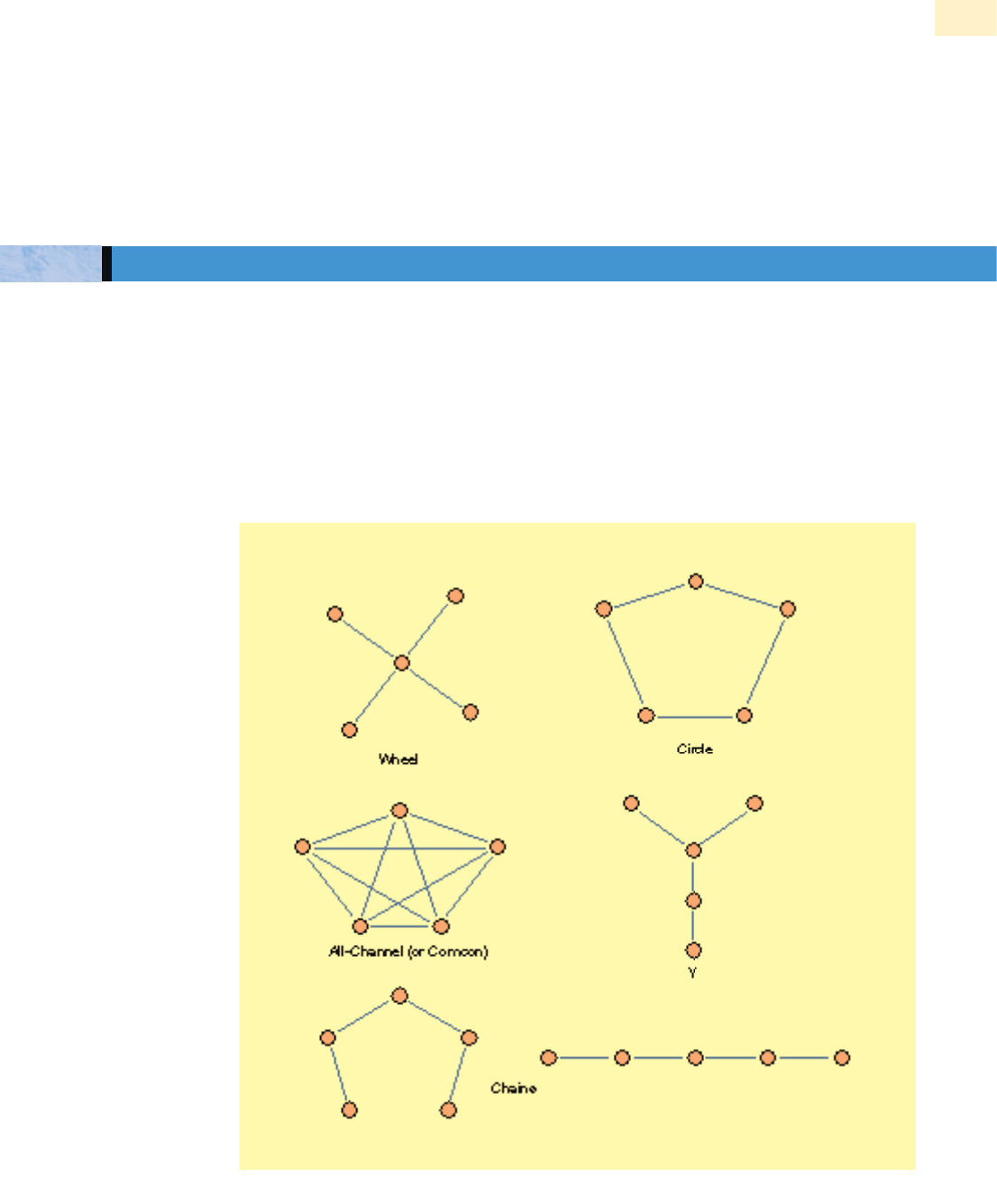
much is still unknown about teams, it is reassuring that further support has been
found for the popular Belbin team-role model. There are several unresolved problems
with teamworking but these might lie more with practices in staff recruitment than in
team theory.
12
An account of profiling managers using the Belbin programme for leadership
development in a cross-section of South African organisations is given in
Management in Action 14.1 at the end of this chapter.
The level of interaction among members of a group or team is influenced by the struc-
turing of channels of communication. Laboratory research by Bavelas
13
and subsequent
studies by other researchers such as Leavitt
14
have resulted in the design of a series of
communication networks. These networks were based on groups of five members
engaged in a number of problem-solving tasks. Members were permitted to communi-
cate with each other by written notes only, and not everyone was always free to
communicate with everyone else.
There are five main types of communication networks – Wheel, Circle, All-Channel,
Y and Chains (see Figure 14.2).
CHAPTER 14 WORKING IN GROUPS AND TEAMS
559
PATTERNS OF COMMUNICATION
Figure 14.2 Communication networks

■ The wheel, also sometimes known as the star, is the most centralised network. This
network is most efficient for simple tasks. Problems are solved more quickly with
fewer mistakes and with fewer information flows. However, as the problems become
more complex and demands on the link person increase, effectiveness suffers. The
link person is at the centre of the network and acts as the focus of activities and
information flows, and the co-ordinator of group tasks. The central person is per-
ceived as leader of the group and experiences a high level of satisfaction. However,
for members on the periphery, the wheel is the least satisfying network.
■
The circle is a more decentralised network. Overall it is less efficient. The group is unor-
ganised, with low leadership predictability. Performance tends to be slow and erratic.
However, the circle is quicker than the wheel in solving complex problems, and also
copes with change or new tasks more efficiently. The circle network is most satisfying
for all the members. Decision-making is likely to involve some degree of participation.
■ The all-channel (or comcon) network is a decentralised network which involves
full discussion and participation. This network appears to work best where a high
level of interaction is required among all the members in order to solve complex
problems. Leadership predictability is very low. There is a fairly high level of satisfac-
tion for members. The all-channel network may not stand up well under pressure, in
which case it will either disintegrate or reform into a wheel network.
■ A ‘Y’ or chain network might be appropriate for more simple problem-solving tasks,
requiring little interaction among members. These networks are more centralised,
with information flows along a predetermined channel. Leadership predictability is
high to moderate. There is a low to moderate level of satisfaction for members.
From a review of studies in communication networks, Shaw confirmed that simple
tasks were consistently undertaken most efficiently in more centralised networks such
as the wheel. More complex tasks were performed more efficiently by decentralised
networks such as the circle or the all-channel.
15
(See Figure 14.3.) The characteristics of
the different communication networks are determined by the extent of ‘independence’
and ‘saturation’.
■ Independence refers to the opportunities for group members to take action and to
solve the problem without relying on the assistance of others.
■ Saturation occurs when the task places an excessive information load or other
demands upon a member of the network. This leads to inefficiency. The central
person in a centralised network handling complex problems is more likely to experi-
ence saturation.
The individual’s satisfaction with his or her position in the network relates to the degree
of independence and the satisfaction of recognition and achievement needs. (See
achievement motivation in Chapter 12.) A high level of dependence on other members
may prevent the satisfaction of these needs, and if members of the network become
frustrated they may not be so willing to share information with others. In the wheel
network the central person has greater independence than the other members, but in
the circle network all members have a moderate degree of dependence upon each other.
Leadership is also important because this can influence the opportunity for independ-
ent action by the group members, and can also control the possibility of saturation.
Despite the obvious artificiality and limitations of these communication network stud-
ies, they do have certain implications for the manager. A knowledge of the findings
may be applied to influence the patterns of communication in meetings and commit-
tees. They also provide a reasonable representation of the situations that might apply
in large organisations. It will be interesting for the manager to observe the patterns of
communication adopted by different groups in different situations. The manager can
also note how communication networks change over time and how they relate to the
560
PART 5 GROUPS AND TEAMWORK
Satisfaction
of group
members
Implications
for the
manager
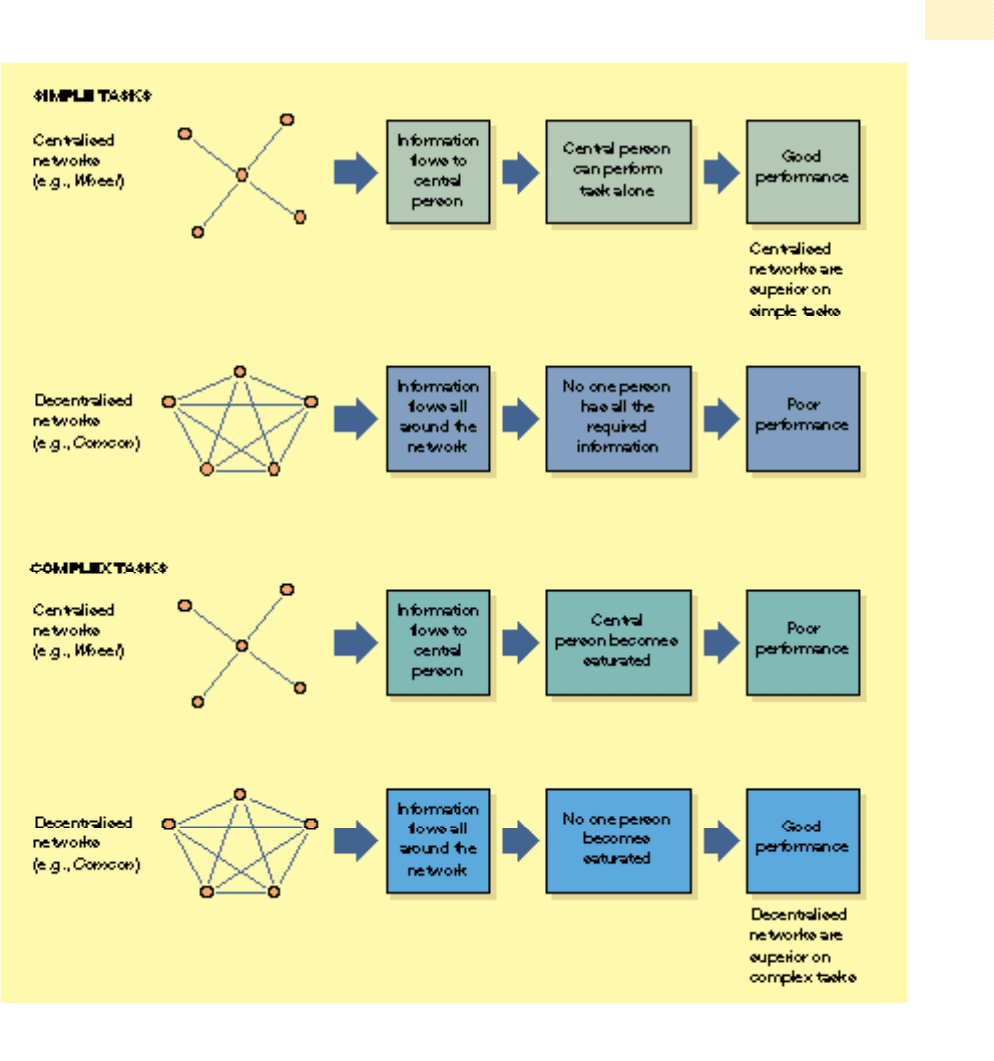
performance of the group. According to Moreland and Levine, patterns of communica-
tion influence the accuracy of transmission and receiving of messages, level of task
performance and the satisfaction of members.
16
No one network is likely to be effective for a range of given problems. The studies
draw attention to the part of the manager’s job which is to ensure the most appropriate
communication network for the performance of a given task. Problems which require a
high level of interaction among members of the group may not be handled efficiently
if there are inadequate channels of communication or sharing of information. The
choice of a particular communication network may involve trade-offs between the per-
formance of the work group and the satisfaction of its members.
CHAPTER 14 WORKING IN GROUPS AND TEAMS
561
Figure 14.3 Communication networks and task complexity
(Source: Baron/Greenberg, Behaviour in Organisations: Understanding Managing, Third edition, Prentice-Hall Inc., Upper Saddle River, NJ. )
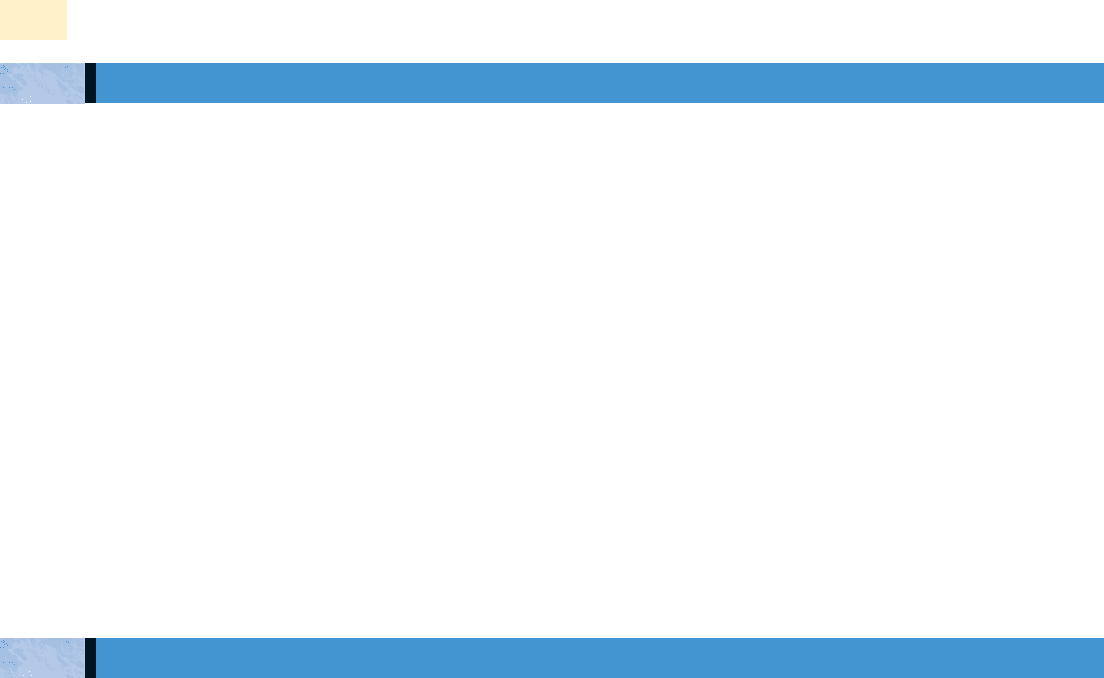
In order to understand and to influence the functioning and operation of a group or
team, it is necessary to study patterns of interaction, and the parts played by individual
members. For example, in a more recent publication Belbin acknowledges that:
Teamwork does not, of course, guarantee in itself good results. As in sport, there can be good
teams and poor teams. And as in sport, it all depends on how the players play together.
17
It is necessary to balance the requirement for effective performance of the team with
respect for the individuality of its members and to achieve the right mix. Not all skilled
and capable individuals are necessarily good team players and it may sometimes be an
advantage to have someone who will have a more sceptical attitude and be more open to
change. For example, Stanley refers to the challenge of managing a high-performance team.
When assembling a high-performance team, you are gathering together energy-packed employ-
ees, who are a lot like thoroughbreds. Keep in mind, they have an innate drive to excel. Their
thoughts run outside the mundane and familiar. With a flare for the unique, they are extraordi-
nary and can generate new ideas that will keep the organisation ahead of the competition …
Along with assigning each member appropriate tasks, the manager must monitor individual per-
formance. By encouraging members to maximise theirindividual effort, the team will greatly
increase the probability of success.
18
Two of the main methods of analysing the behaviour of individuals in group situations
are sociometry and interaction process analysis.
Originally developed by Moreno,
19
sociometry is a method of indicating the feelings of
acceptance or rejection among members of a group. A sociogram is a diagrammatical
illustration of the pattern of interpersonal relationships derived from sociometry. The
sociogram depicts the choices, preferences, likes or dislikes, and interactions between
individual members. It can also be used to display the structure of the group and to
record the observed frequency and/or duration of contacts among members.
The basis of sociometry, however, is usually ‘buddy rating’ or ‘peer rating’. Each
member is asked to nominate or to rate, privately, other members in terms of some
given context or characteristic – for example, with whom they communicate, or how
influential or how likeable they are. Questions may relate to either work or social activi-
ties. For example: who would you most prefer or least prefer as a workmate? Who would
make a good leader? With whom would you choose and not choose to go on holiday?
Positive and negative choices may be recorded for each person, although sometimes
positive choices only are required. The choices may be limited to a given number or
they may be unlimited. Sometimes individuals may be asked to rank their choices.
Members’ choices could be shown in tabular form. For example, Table 14.2 shows first and
second choices for a group of final-year degree students. Members were asked to indicate,
in confidence, those whom they would most prefer to talk to about: (i) a major work-
related problem; and (ii) a difficult personal problem. Positive choices only were requested.
An advantage of the diagrammatical illustration, however, is that the sociogram pro-
vides a visual description of the sociometric structure of a group. It can indicate cliques
and sub-groups, compatibility, and members who are popular, isolated or who act as
links. Figure 14.4 gives a simple illustration of an actual sociogram for a group of 15
members with single, positive choices only.
1G and M are popular (the stars) and most often chosen by members.
2M is the link between two overlapping cliques, KML and MNO.
3H and P are unpopular (isolated) and chosen least by members.
PART 5 GROUPS AND TEAMWORK
ANALYSIS OF INDIVIDUAL BEHAVIOUR
562
SOCIOMETRY
Sociograms
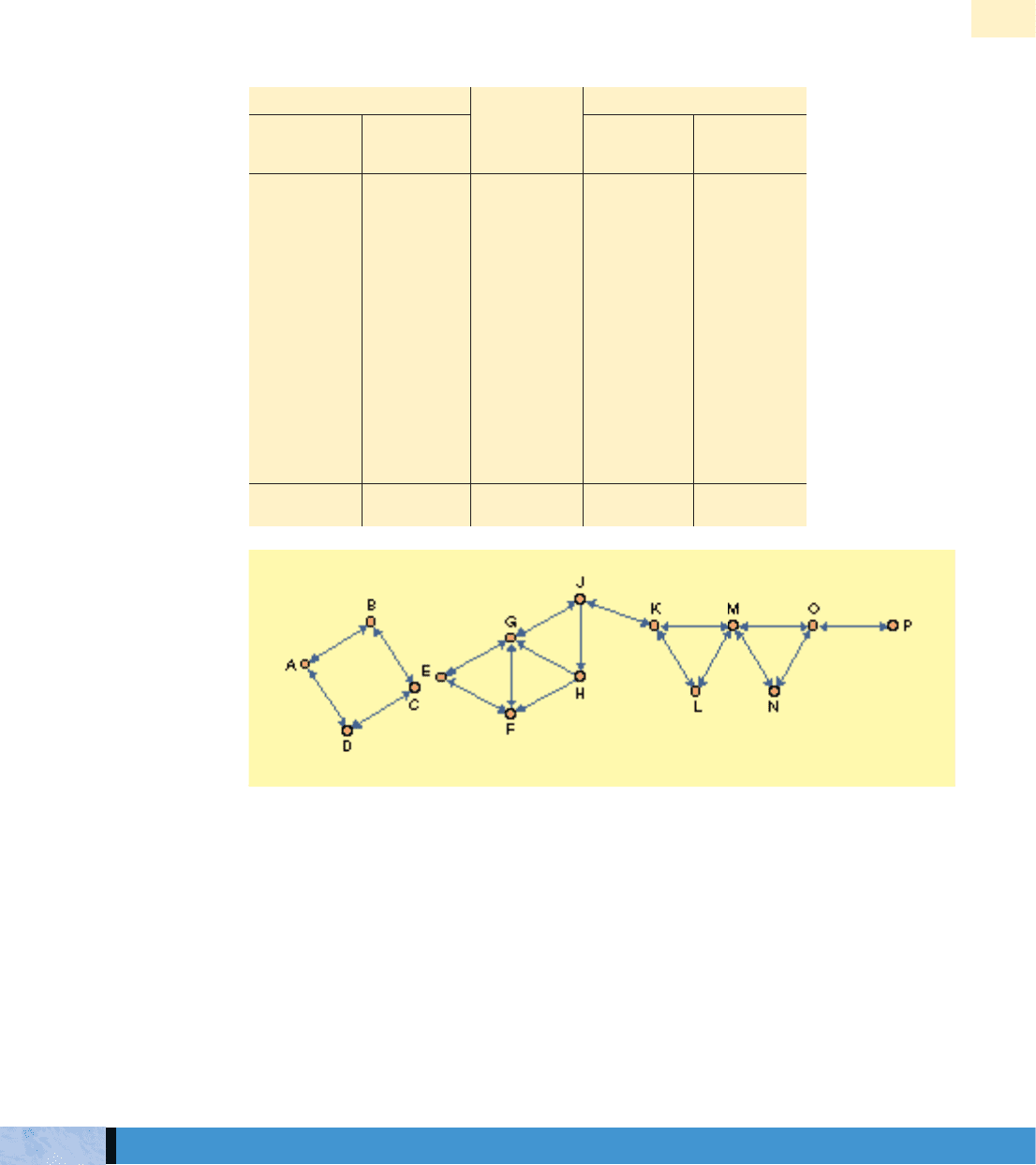
4 JKMO is a chain.
5 ABCD is a sub-group and separated from the rest of the members.
It should be noted, however, that there are several methods of compiling and drawing
sociograms, and a number of potential criticisms and limitations with the contribution
of Moreno. Problems also arise over how to draw the sociogram and how to interpret the
roles of individual members; ‘the drawing of a sociogram is a highly arbitrary and time-
consuming task’.
20
In the experience of the author less concern should be given to the
concept of sociometry itself. It is better seen as a useful vehicle which, if handled sensi-
tively, can serve to encourage meaningful discussions on patterns of social interactions,
group behaviour and the perceptions of individual members towards one another.
The basic assumption behind interaction analysis is that behaviour in groups may be
analysed from the viewpoint of its function. This approach has developed largely from
the work of Bales on methods for the study of small groups. This aim is to provide ways
of describing group process and indications of factors influencing the process.
21
In Bales’s
CHAPTER 14 WORKING IN GROUPS AND TEAMS
563
Work-related problem Personal problem
Second First First Second
choice choice choice choice
A ///
B/ //
/// / C // /
/D//
E/
F/ //
/G//
///// // H //
J/ /
// K
//// /////// L //
/M//
N//
/O/
14 14 14 14
Table 14.2 Example of a ‘tabulated’ sociogram (positive choices only)
Figure 14.4 A simple illustration of a sociogram
INTERACTION ANALYSIS

‘Interaction Process Analysis’ every act of behaviour is categorised, as it occurs, under
twelve headings. These differentiate between ‘task’ functions and ‘socio-emotional’ func-
tions. The categories apply to both verbal interaction and non-verbal interaction.
A Socio-Emotional: Positive Reactions
1 Shows solidarity, raises others’ status, gives help, reward.
2 Shows tension release, jokes, laughs, shows satisfaction.
3 Agrees, shows passive acceptance, understands, concurs, complies.
BTask: Attempted Answers
4 Gives suggestion, direction, implying autonomy for others.
5 Gives opinion, evaluation, analysis, expresses feeling, wish.
6 Gives orientation, information, repeats, clarifies, confirms.
CTask: Questions
7 Asks for orientation, information, repetition, confirmation.
8 Asks for opinion, evaluation, analysis, expression of feeling.
9 Asks for suggestion, direction, possible ways of action.
D Socio-Emotional: Negative Reactions
10 Disagrees, shows passive rejection, formality, withholds help.
11 Shows tension, asks for help, withdraws out of field.
12 Shows antagonism, deflates others’ status, defends or asserts self
In an extension of interaction process analysis, Bales gives 27 typical group roles which
are based on various combinations of these original main behavioural categories.
22
Task and maintenance functions
If the group is to be effective, then, whatever its structure or the pattern of interrela-
tionships among members, there are two main sets of functions or processes that must
be undertaken – task functions and maintenance functions.
■ Task functions are directed towards problem-solving, the accomplishment of the
tasks of the group and the achievement of its goals. Most of the task-oriented behav-
iour will be concerned with ‘production’ activities, or the exchange and evaluation
of ideas and information.
■ Maintenance functions are concerned with the emotional life of the group and
directed towards building and maintaining the group as an effective working unit.
Most of the maintenance-oriented behaviour will be concerned with relationships
among members, giving encouragement and support, maintaining cohesiveness and
the resolution of conflict.
Task and maintenance functions may be performed either by the group leader or by
members. Ultimately it is the leader’s responsibility to ensure that both sets of func-
tions are carried out and the right balance is achieved between them. The appropriate
combination of task-oriented behaviour and maintenance-oriented behaviour is essen-
tial to the success and continuity of the group.
In addition to these two types of behaviour members of a group may say or do
something in attempting to satisfy some personal need or goal. The display of behav-
iour in this way is termed self-oriented behaviour. This gives a classification of three
main types of functional behaviour which can be exhibited by individual members of a
group: task-oriented, maintenance-oriented and self-oriented.
A popular system for the classification of member roles in the study of group behaviour
is that devised originally by Benne and Sheats.
23
The description of member roles per-
formed in well-functioning groups is classified into three broad headings: group task
roles, group maintenance roles and individual roles.
564
PART 5 GROUPS AND TEAMWORK
Classification
of member
roles
